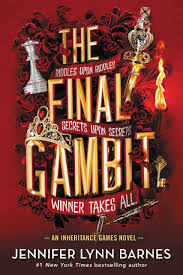
The Final Gambit (The Inheritance Games)
CHAPTER 85
by Barnes, Jennifer LynnThe chapter opens with Jameson’s playful declaration, “The knight returns with the damsel in distress,” as he greets the protagonist and Grayson. The protagonist, exhilarated by her recent victory, feels an intense connection with Jameson, who alone understands the thrill of her triumph. The moment is described with vivid metaphors—comparing the rush of success to standing at the edge of a waterfall or discovering the ability to fly. Jameson offers her a ride home in a helicopter, defying rules with his characteristic daring, and challenges her to learn to fly, symbolizing their shared appetite for adventure and risk.
Later, the protagonist reflects on a puzzle cube given to her by Toby, which she disassembles to reveal carved words: “I see so much of your mother in you.” This emotional revelation becomes a pivotal moment, deepening her self-awareness and resolve. The message from Toby serves as a catalyst, reinforcing her connection to her past and strengthening her determination to embrace her future. This introspection contrasts with the earlier adrenaline-fueled scenes, highlighting her growth and the weight of her decisions.
The next morning, the protagonist visits the Great Room, where the Hawthorne family’s will was originally read, and burns the trust paperwork that would have temporarily absolved her of responsibility. With Libby’s encouragement, she chooses to fully accept the power and challenges of her inheritance. The act of burning the papers symbolizes her rejection of hesitation and her readiness to take control. The imagery of flames and blooming tulips underscores her transformation and newfound confidence.
In the final section, the protagonist commits to her vision, carrying Grayson’s leather notebook as she prepares to implement her plans swiftly. She acknowledges the potential backlash from lawyers and financial advisors but remains resolute in her unconventional path. The chapter closes with a sense of urgency and determination, as she embraces her role as a decisive leader, unafraid to challenge the status quo and make bold moves. Her journey from triumph to self-assured action marks a defining moment in her story.
FAQs
1. How does the protagonist’s emotional state after her victory reflect her relationship with Jameson?
Answer:
The protagonist describes her victorious moment with intense sensory language—comparing it to standing at a powerful waterfall, jumping off a cliff, and discovering flight. This euphoric state mirrors her connection with Jameson, who is portrayed as the only person who could fully understand this triumph. The phrase “Jameson-and-me” suggests their relationship is intertwined with these peak emotional experiences, indicating they share a deep, almost symbiotic understanding of each other’s highs and thrills (Chapter 85, paragraphs 3–7).2. Analyze the significance of Toby’s puzzle cube message and its impact on the protagonist.
Answer:
The disassembled cube reveals the carved words: “I see so much of your mother in you.” This moment is pivotal, as the protagonist notes it affects her more deeply than defeating Blake. The message likely connects to her identity and legacy, serving as emotional validation or closure regarding her mother. It underscores a theme of inheritance—not just wealth, but personal traits and relationships—which contrasts with the financial inheritance central to the plot (Chapter 85, paragraphs 11–19).3. What symbolic meaning does burning the trust paperwork hold, and how does it relate to the protagonist’s growth?
Answer:
By burning the trust documents in the Great Room (where the Hawthorne will was originally read), the protagonist rejects the option to delegate her responsibility. The act symbolizes her acceptance of agency and power, with the fire representing transformation. The imagery of tulip petals blooming within her reinforces this growth, showing she has moved from uncertainty to confidence in her capability to manage the Hawthorne legacy (Chapter 85, paragraphs 20–28).4. How does the chapter foreshadow the protagonist’s future actions, and what conflict might arise?
Answer:
The final paragraphs hint at impending conflict: the protagonist’s leather notebook and unspecified plans suggest she will challenge the “status quo,” likely by redistributing wealth or power in unconventional ways. The mention that lawyers and advisors “won’t like it” foreshadows resistance from established systems, setting up a clash between her vision and traditional structures of authority (Chapter 85, paragraphs 29–33).
Quotes
1. “It was like jumping off a cliff and finding out you could fly. It was like Jameson and me and Jameson-and-me, and I wanted to live it all over again with him.”
This quote captures the protagonist’s euphoric realization of victory and her deep emotional connection with Jameson. It represents a pivotal moment of triumph and intimacy in the chapter.
2. “On each one, he’d carved a word. I / See / So / Much / Of / Your / Mother / In / You.”
This poignant message from Toby serves as a powerful emotional revelation for the protagonist, showing her a deeper connection to her past and identity. It’s the moment she truly understands something fundamental about herself.
3. “As the flames licked at the pages, devouring the legalese and, with it, the option to foist the power and responsibility I’d been given off on anyone else, I felt something in me begin to loosen, like the petals of a tulip opening to the slightest bloom.”
This symbolic act of burning the trust paperwork represents the protagonist’s decisive acceptance of her inheritance and responsibility. The beautiful imagery captures her personal growth and readiness to embrace her future.
4. “If the past year had been any kind of test—I was ready.”
This concise statement serves as the chapter’s powerful conclusion, showing the protagonist’s transformation and newfound confidence. It encapsulates her journey and prepares readers for what comes next.
